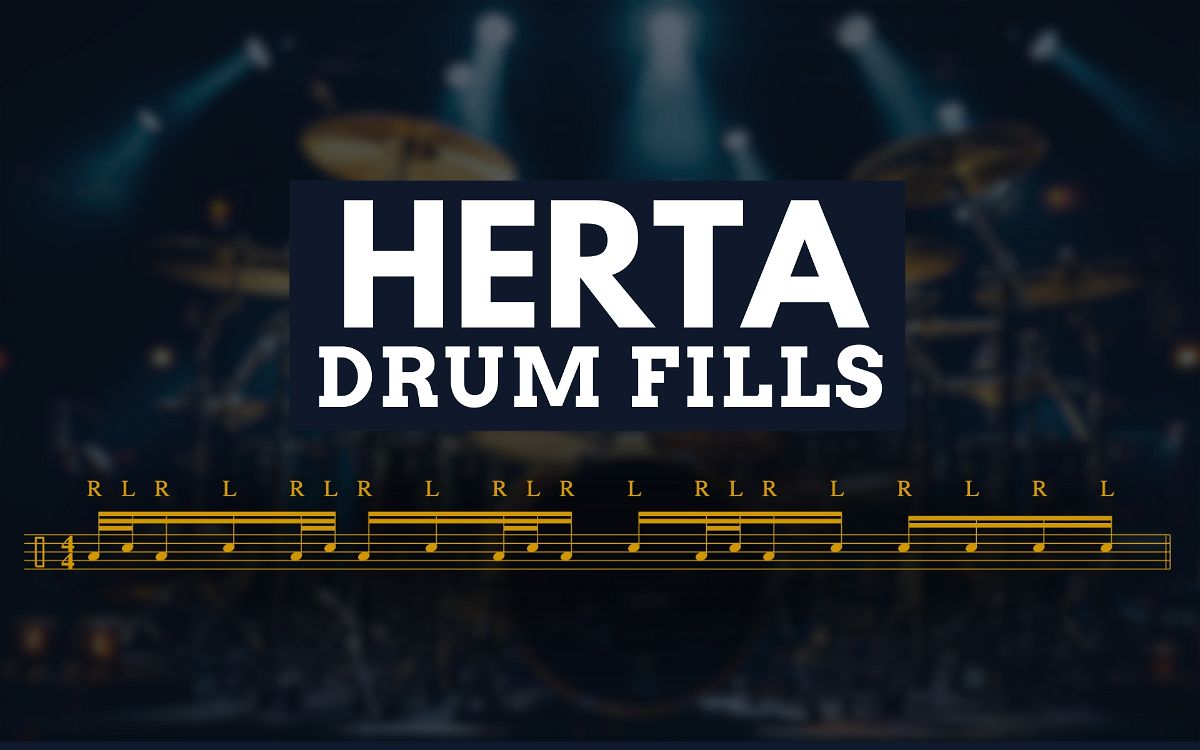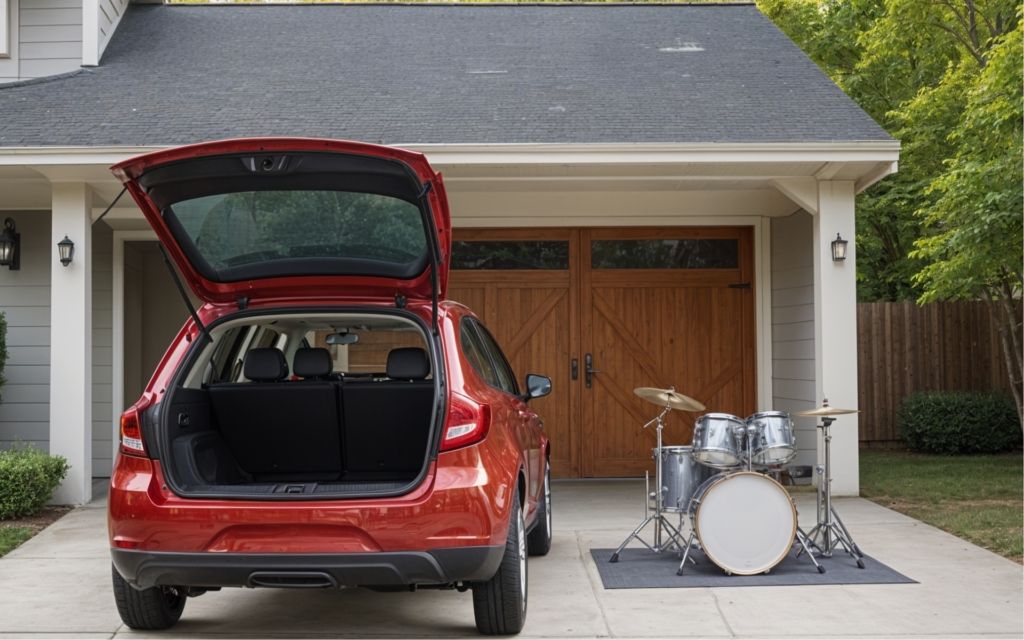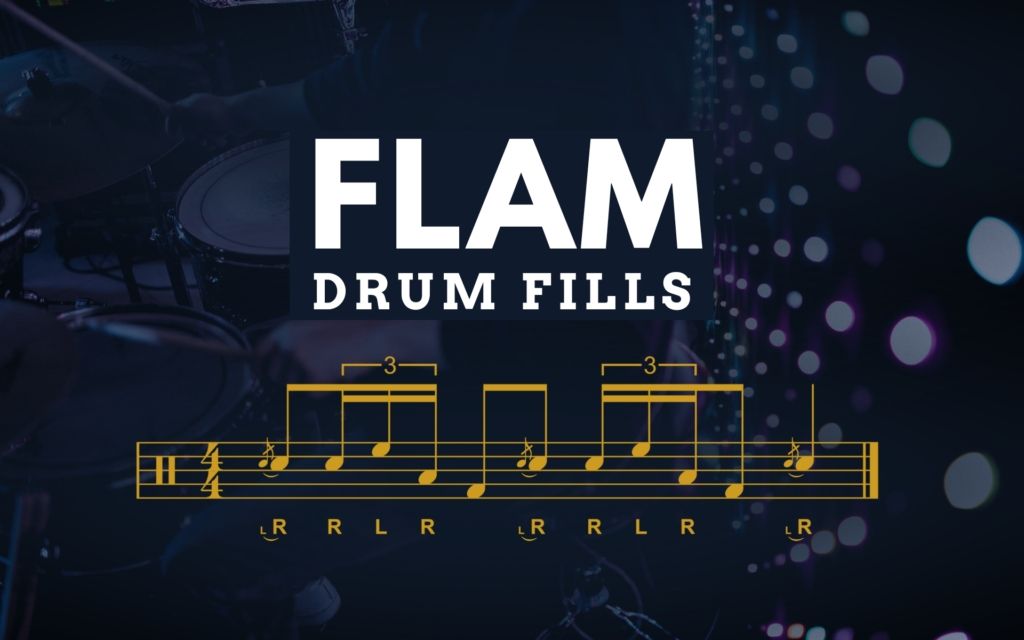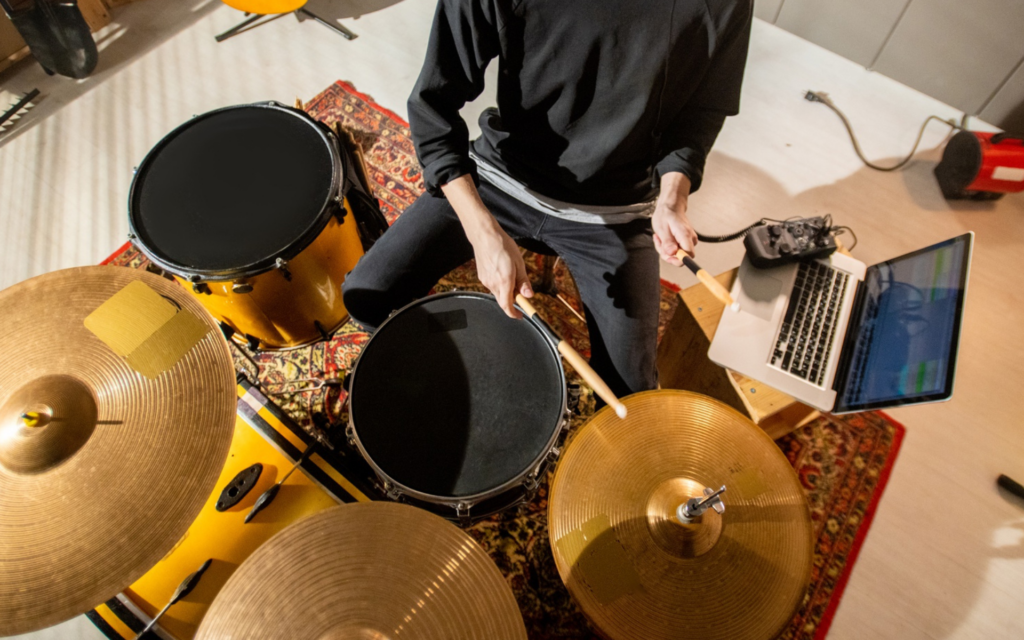A herta is one of the best patterns to add a bit of spice and excitement to your drum fills. While it’s not technically a rudiment, drummers play hertas so often that a lot of people assume it is one.
Before we get into the drum fill ideas, let’s look at the basic herta pattern. Essentially, you’re going to play two quick notes in a row and alternate your hands with them.
You’re then going to play two longer notes. The first two notes will be 32nd notes, while the second two notes will be 16ths.
Now that we’ve got that covered, let’s look at some interesting herta drum fills that will brighten up your playing.
Contents
Herta Fill 1

For this first drum fill, we’re going to move the herta pattern around the kit. We’ll start by playing it on the snare drum, then we’ll go to the rack tom, and then we’ll end off on the floor tom.
To round the fill out, we’ll play regular 16th notes on the floor tom starting on beat 4 of the bar.
The first drum fill will be quite easy to learn, so it’s a good one to focus on developing that herta pattern. You could play a groove three times and then have this as the fourth bar, but you could also simply repeat the fill over and over to build your muscle memory for the pattern.
Herta Fill 2

In this next fill, you’re going to start off by playing two herta patterns on the snare drum. You’ll then play straight 16th notes on the snare on the “and” count of beat 2.
On beat 3, you’ll play single notes around the kit. Start with your right hand on the snare and then move to the rack tom with your left hand. You’ll then play the floor tom with your right hand, followed by a strong kick drum note.
On beat 4, you’ll play a strong snare drum note with your left hand, followed by a third herta pattern to finish the fill off.
Herta Fill 3

We’re going to use displacement here, which means that you’re going to move notes ahead in a bar. Instead of starting with a herta pattern, you’re going to start each main count with a bass drum.
You’ll then have a small rest before playing the herta pattern on each drum. This is a fantastic chop that Gospel drummers regularly use, and the herta pattern is the key to building a bit of speed with it.
While I’m showing you exact note placements, you should also experiment with moving this particular pattern around in different ways.
Herta Fill 4

Our next fill follows the same idea as the last one, but you’re going to split your hands across different surfaces.
Instead of playing each herta pattern on a single drum, you’re going to play the first two notes on the rack tom and the last two notes on the snare drum.
This fill sounds incredibly slick and tasty when you speed it up, so make sure you practice this one until you can play it at a high BPM.
Herta Fill 5

Let’s stick with the idea of splitting our hands. Doing this is a fantastic way of making the herta pattern sound a bit more creative. For this fill, you’re going to keep your right hand on the floor tom and your left hand on the snare.
You’ll then play four herta patterns in a row, and then finish the bar off by playing four alternating 16th notes on the snare drum.
I love how this sounds. If you play rimshots for the snare drum notes, you almost get a blast beat sound, but this fill works well in any style of music.
Herta Fill 6

For this fill, you’re going to use the exact same model as the last one, but you’re going to change where one of your right hand strokes land. This will completely change the sound of the fill, showing how valuable patterns can be when you just experiment with them a bit.
Instead of keeping your right hand on the floor tom the whole time, you’re going to move it to the hi-hat in each herta group. Make sure to strike the hi-hat quite hard so that it can clearly be heard.
This is another type of drum lick that you’ll regularly hear from drummers like Eric Moore and Tony Royster Jr.
Herta Fill 7

In this next fill, the herta pattern will be more of a tasteful inclusion rather than being the main focus.
You’re going to start the fill by playing 16th notes on the snare for beat 1. For beat 2, you’ll play the herta pattern twice on the snare.
You’ll end beat 3 by playing alternating snares from the “and” count. To end the bar, you’ll continue playing alternating singles around the drums.
Make sure that you play the first four snare drum notes quite loudly. Those set the scene for this fill and establish the energetic sound of the entire thing.
Herta Fill 8

The notation for this next fill looks very complicated, but it’s a lot easier to play than how it looks. All you’re going to do is leave your right hand on the bell of the ride cymbal and your left hand on the snare drum.
You’re then going to play four herta patterns in a row between those two surfaces. Every time you start a new herta pattern, you’re going to play the bass drum.
Finally, you’re going to end the drum fill by playing a strong flam on the snare drum on beat 4 of the bar.
Again, this gives you a sort of blast beat sound, but it sounds so tasteful when you pull this out for a lively drum fill.
Herta Fill 9

This fill will also have you playing four herta patterns in a row, but you’re going to split your hands up for each note.
The first note will be played on the snare drum with your right hand. The second will be played on the rack tom with your left hand. The third will be played on the floor tom with your right hand. The fourth will be played on the hi-hat with your left hand.
After that, you’re going to play the snare drum and floor tom together, followed by two kick drum notes with a rest in between them.
Herta Fill 10

In this last fill, you’re going to start by playing a single stroke around the kit on beat 1. You’ll replace the final left hand stroke with a bass drum.
You’re then going to keep your right hand on the floor tom and your left hand on the snare drum. From there, you’ll play two hertas. You’ll then round beat 3 off by playing a floor tom and snare drum. You’ll then end the fill by playing one last herta between the snare and the floor tom.
However, there will be one note left that you need to play on the floor tom with your right hand. This means you’ll need to crash with your left hand on beat 1 of the next bar.
Conclusion
With those 10 drum fills, you should have a good understanding of how powerful the herta pattern can be on the drum kit.
I’d recommend practicing those so that you can play them around 120 BPM. Once you’re there, you should be confident creating your own drum fills using the herta pattern.









